
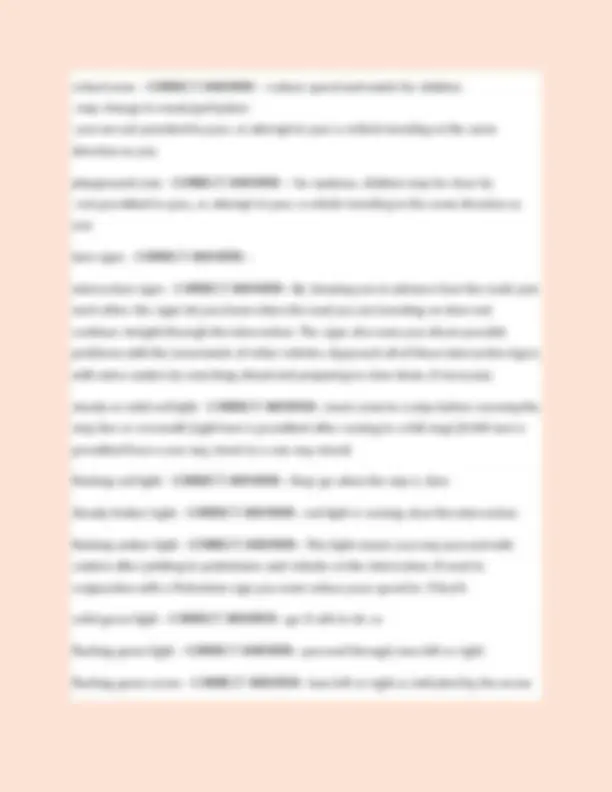
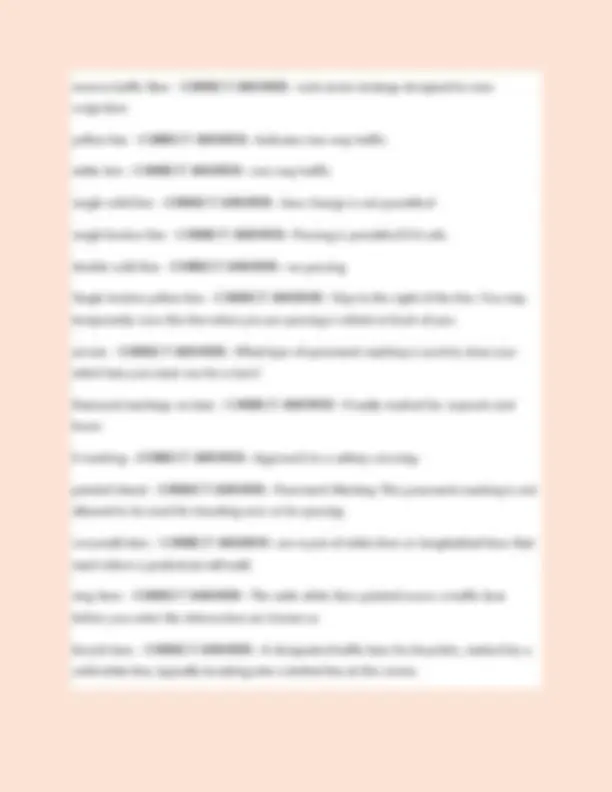
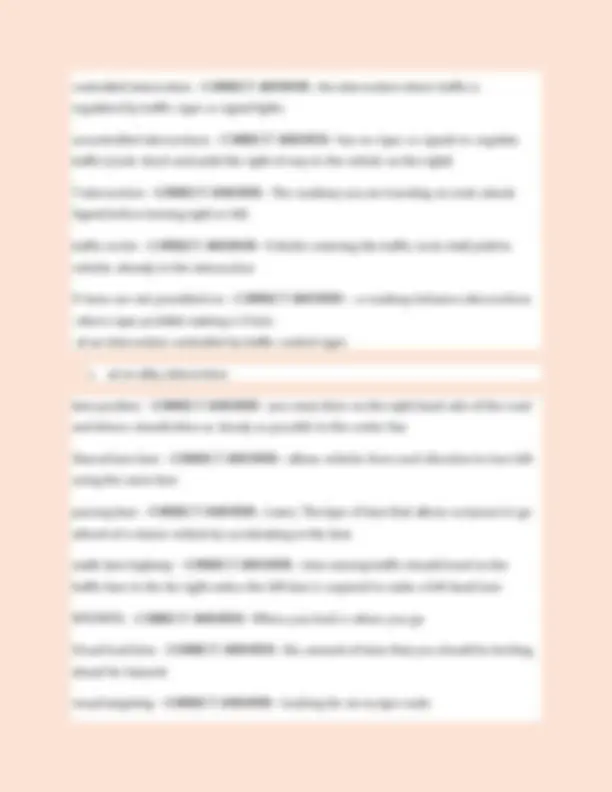
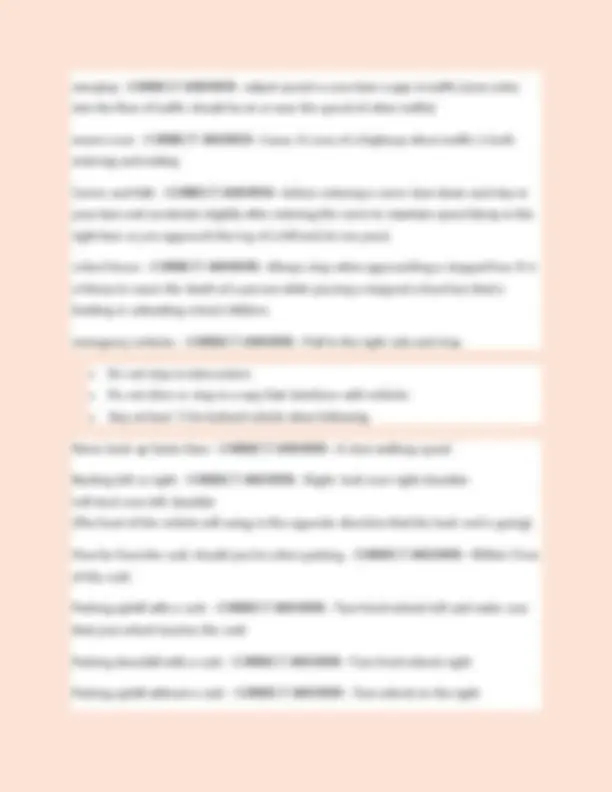
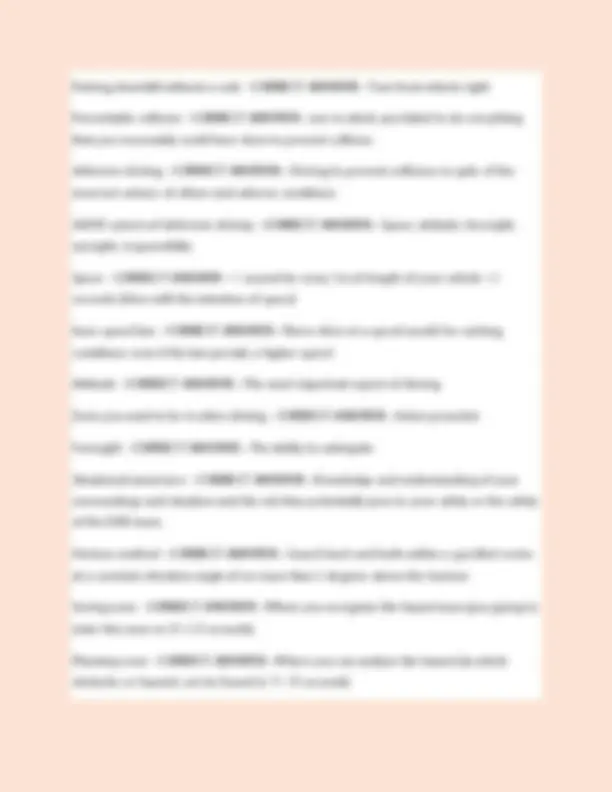
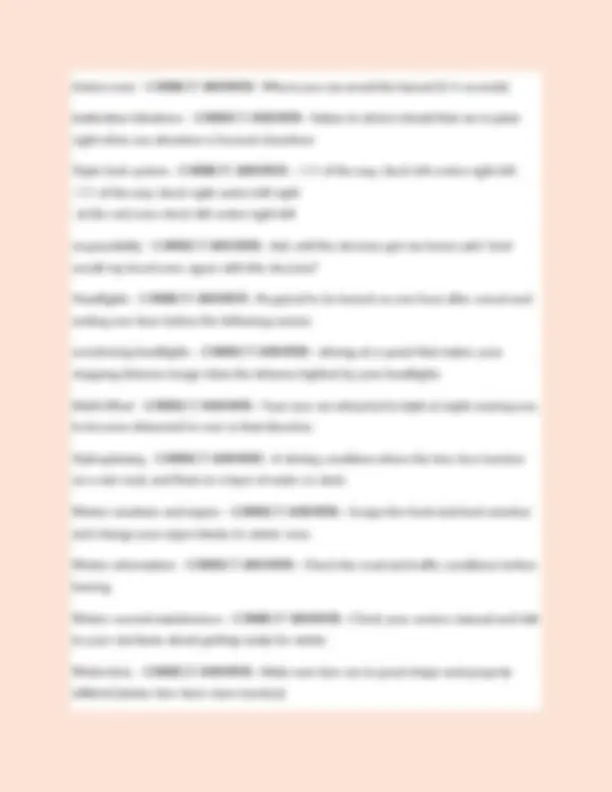
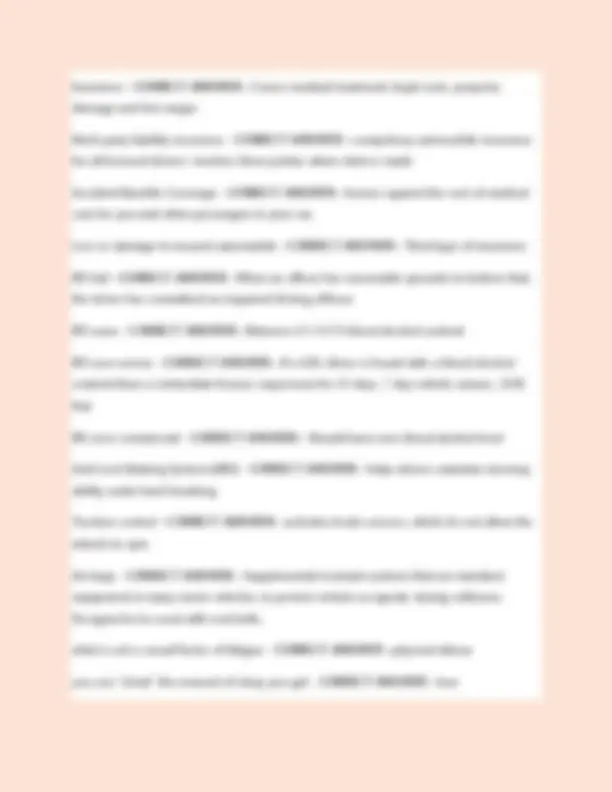
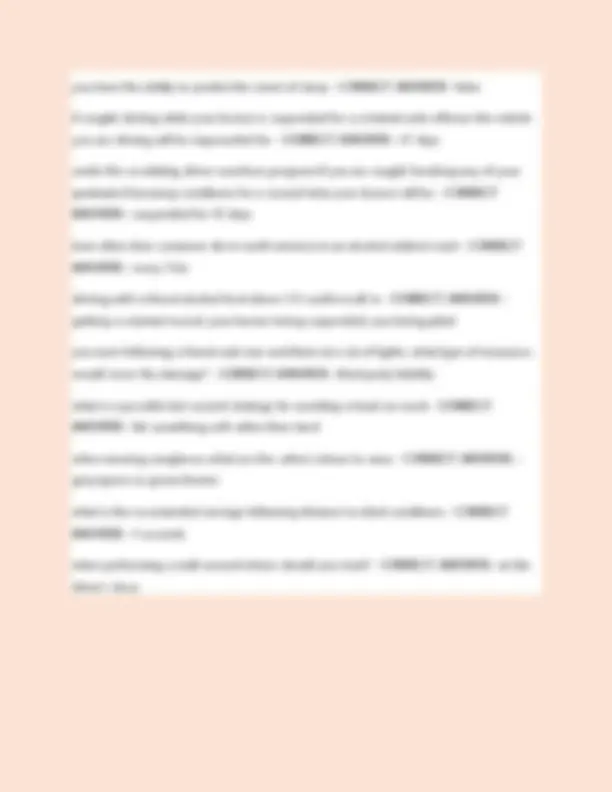


Study with the several resources on Docsity

Earn points by helping other students or get them with a premium plan


Prepare for your exams
Study with the several resources on Docsity

Earn points to download
Earn points by helping other students or get them with a premium plan
Community
Ask the community for help and clear up your study doubts
Discover the best universities in your country according to Docsity users
Free resources
Download our free guides on studying techniques, anxiety management strategies, and thesis advice from Docsity tutors
Taking the basic test - CORRECT ANSWER--expected to drive in a safe and reasonable manner -no pets or passengers -all road tests have a set time frame -the examiner is not allowed to coach you during the test
Typology: Exams
1 / 14

This page cannot be seen from the preview
Don't miss anything!









Taking the basic test - CORRECT ANSWER-- expected to drive in a safe and reasonable manner
Emergency brake - CORRECT ANSWER-- (n) a brake operated by hand, which is often used when parking a car Exterior mirror - CORRECT ANSWER-- Adjust the mirror and remember that you need to see a slim line of your car Signal arm - CORRECT ANSWER-- Pull up to turn right and press down to turn left no left turn - CORRECT ANSWER-- official bike road - CORRECT ANSWER-- you may not drive straight through the intersection - CORRECT ANSWER-- arrow with a line through it stop signs - CORRECT ANSWER-- - if there is no stop line stop at the crosswalk
reverse traffic flow - CORRECT ANSWER-- rush arrow strategy designed to ease conjestion yellow line - CORRECT ANSWER-- Indicates two-way traffic white line - CORRECT ANSWER-- one-way traffic single solid line - CORRECT ANSWER-- lane change is not premitted single broken line - CORRECT ANSWER-- Passing is permitted if it safe. double solid line - CORRECT ANSWER-- no passing Single broken yellow line - CORRECT ANSWER-- Stay to the right of the line. You may temporarily cross this line when you are passing a vehicle in front of you. arrows - CORRECT ANSWER-- What type of pavement marking is used to show you which lane you must use for a turn? Diamond markings on lane - CORRECT ANSWER-- Usually marked for carpools and buses X marking - CORRECT ANSWER-- Approach to a railway crossing. painted island - CORRECT ANSWER-- Pavement Marking: This pavement marking is not allowed to be used for traveling over or for passing. crosswalk lines - CORRECT ANSWER-- are a pair of white lines or longitudinal lines that mark where a pedestrian will walk. stop lines - CORRECT ANSWER-- The wide white lines painted across a traffic lane before you enter the intersection are known as bicycle lane - CORRECT ANSWER-- A designated traffic lane for bicyclists, marked by a solid white line, typically breaking into a dotted line at the corner.
controlled intersection - CORRECT ANSWER-- An intersection where traffic is regulated by traffic signs or signal lights. uncontrolled intersections - CORRECT ANSWER-- has no signs or signals to regulate traffic (circle check and yield the right of way to the vehicle on the right) T intersection - CORRECT ANSWER-- The roadway you are traveling on ends ahead. Signal before turning right or left. traffic circles - CORRECT ANSWER-- Vehicles entering the traffic circle shall yield to vehicles already in the intersection U turns are not premitted on - CORRECT ANSWER-- - a roadway between intersections
merging - CORRECT ANSWER-- adjust speed so you have a gap in traffic (your entry into the flow of traffic should be at or near the speed of other traffic) weave zone - CORRECT ANSWER-- Lanes: A zone of a highway where traffic is both entering and exiting Curves and hills - CORRECT ANSWER-- before entering a curve slow down and stay in your lane and accelerate slightly after entering the curve to maintain speed (keep in the right lane as you approach the top of a hill and do nor pass) school buses - CORRECT ANSWER-- Always stop when approaching a stopped bus. It is a felony to cause the death of a person while passing a stopped school bus that is loading or unloading school children. emergency vehicles - CORRECT ANSWER-- Pull to the right side and stop
Action zone - CORRECT ANSWER-- Where you can avoid the hazard (4-6 seconds) Inattention blindness - CORRECT ANSWER-- failure to detect stimuli that are in plain sight when our attention is focused elsewhere Triple look system - CORRECT ANSWER-- - 1/3 of the way check left centre right left
Winter: emergency kit - CORRECT ANSWER-- Bring warm winter clothing, shovel, blanket, jumper cables, emergency sign, flashlight, first aid kit, and high energy snacks Winter: roads - CORRECT ANSWER-- Think about the types of roads you will be driving on and the possible hazards Gravel roads - CORRECT ANSWER-- Steering is loose, poor visibility from dust, flying rocks, road signs are not well posted, and ditches may be too dangerous to enter black ice - CORRECT ANSWER-- a coating of ice on the road that is nearly invisible to drivers (caused by snow melting and re-freezing) Safe brake down procedure - CORRECT ANSWER-- - signal, slow down and move off the road
Insurance - CORRECT ANSWER-- Covers medical treatment, legal costs, property damage and lost wages third-party liability insurance - CORRECT ANSWER-- compulsory automobile insurance for all licensed drivers' involves three parties when claim is made Accident Benefits Coverage - CORRECT ANSWER-- Insures against the cost of medical care for you and other passengers in your car. Loss or damage to insured automobile - CORRECT ANSWER-- Third type of insurance IRS fail - CORRECT ANSWER-- When an officer has reasonable grounds to believe that the driver has committed an impaired driving offence IRS warn - CORRECT ANSWER-- Between 0.5-0.079 blood alcohol content IRS zero novice - CORRECT ANSWER-- If a GDL driver is found with a blood alcohol content there is immediate license suspension for 30 days, 7 day vehicle seizure, 200$ fine IRS zero commercial - CORRECT ANSWER-- Should have zero blood alcohol level Anti-Lock Braking System (ABS) - CORRECT ANSWER-- helps drivers maintain steering ability under hard breaking. Traction control - CORRECT ANSWER-- activates brake sensors, which do not allow the wheels to spin Air bags - CORRECT ANSWER-- Supplemental restraint systems that are standard equipment in many newer vehicles, to protect vehicle occupants during collisions. Designed to be used with seat belts. what is not a casual factor of fatigue - CORRECT ANSWER-- physical labour you can "cheat" the amount of sleep you get - CORRECT ANSWER-- true
you have the ability to predict the onset of sleep - CORRECT ANSWER-- false if caught driving while your license is suspended for a criminal code offence the vehicle you are driving will be impounded for - CORRECT ANSWER-- 45 days under the escalating driver sanctions program if you are caught breaking any of your graduated licensing conditions for a second time your license will be - CORRECT ANSWER-- suspended for 90 days how often does someone die in north america in an alcohol related crash - CORRECT ANSWER-- every 30m driving with a blood alcohol level above 0.8 could result in - CORRECT ANSWER-- getting a criminal record, your license being suspended, you being jailed you were following a friend and rear end them at a set of lights. what type of insurance would cover the damage? - CORRECT ANSWER-- third party liability what is a possible last second strategy for avoiding a head on crash - CORRECT ANSWER-- hit something soft rather then hard when wearing sunglasses what are the safest colours to wear - CORRECT ANSWER-- grey/green or green/brown what is the recomended average following distance in ideal conditions - CORRECT ANSWER-- 4 seconds when performing a walk around where should you start? - CORRECT ANSWER-- at the driver's door